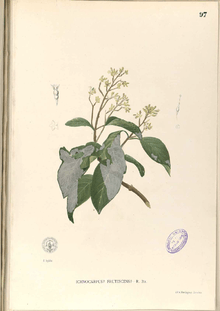Ichnocarpus frutescens
| black creeper | |
|---|---|
 | |
| Ichnocarpus frutescens [1] | |
| Scientific classification | |
| Kingdom: | Plantae |
| (unranked): | Angiosperms |
| (unranked): | Eudicots |
| (unranked): | Asterids |
| Order: | Gentianales |
| Family: | Apocynaceae |
| Genus: | Ichnocarpus |
| Species: | I. frutescens |
| Binomial name | |
| Ichnocarpus frutescens (L.) W.T.Aiton[2][3] | |
Ichnocarpus frutescens is a species of flowering plant in the dogbane family known by the English common name black creeper. It is native to much of China, India, Southeast Asia, and northern Australia.[2][3] In Uttarakhand it is known as kali-dudhi,[4] and as botilai[5] and shyamlata in Orissa,[6] dudhilata in Madhya Pradesh,[7] palvalli in Tamil Nadu,[8] and siamlata in Uttar Pradesh.[9]
It is a woody shrub with lianas sprawling to 10 meters in maximum length and 6 centimeters in diameter. The bark produces a creamy white sap. The leaves are up to 11 centimeters long by 4.5 wide. The inflorescence is a head of several flowers. Each flower has a calyx of densely hairy sepals and a five lobed corolla just under a centimeter long. The fruit is a follicle which may be over 14 centimeters long. The roots may be reddish or purple. The plant is sold in markets in some areas in India.[7]
Uses
The plant has a large number of traditional medicinal uses, including treatment for rheumatism, asthma, cholera, and fever.[4] Some in vitro and rodent studies have suggested that extracts of the plant inhibit tumors,[10] protect liver cells from damage in acetaminophen overdose,[5] and reduces complications of hyperlipidemia in diabetic rats.[11] There have been no published studies testing any of these effects in humans.
The fibrous bark is used to make rope.[2]
References
- ↑ illustration circa 1880, from Francisco Manuel Blanco (O.S.A.) - Flora de Filipinas
- ↑ 2.0 2.1 2.2 Li, Bingtao; Leeuwenberg, Antony J. M.; Middleton, David J. (2008) [1995]. Wu, Z. Y.; Raven, P. H., eds. "Ichnocarpus frutescens, Apocynaceae, Vol. 16". Flora of China. Online access. eFloras.org. St. Louis, MO & Cambridge, MA.: Missouri Botanical Garden Press and Harvard University Herbaria. Retrieved 9 Mar 2013.
- ↑ 3.0 3.1 Hyland, B. P. M.; Whiffin, T.; Zich, F. A. et al. (Dec 2010). "Factsheet – Ichnocarpus frutescens". Australian Tropical Rainforest Plants. Edition 6.1, online version [RFK 6.1]. Cairns, Australia: Commonwealth Scientific and Industrial Research Organisation (CSIRO), through its Division of Plant Industry; the Centre for Australian National Biodiversity Research; the Australian Tropical Herbarium, James Cook University. Retrieved 13 Mar 2013.
- ↑ 4.0 4.1 Adhikari, B. S., et al. (2010). Medicinal Plants Diversity and their Conservation Status in Wildlife Institute of India (WII) Campus, Dehradun. Ethnobotanical Leaflets 14 46-83.
- ↑ 5.0 5.1 Dash, D. K., et al. (2007). Evaluation of hepatoprotective and antioxidant activity of Ichnocarpus frutescens (Linn.) R.Br. on paracetamol-induced hepatotoxicity in rats. Tropical Journal of Pharmaceutical Research 6:3 755-65.
- ↑ Ashutosh, M, et al. (2009). Analgesic and anti-inflammatory effect of Ichnocarpus frutescens plant parts. Int J Ph Sci 1:2 280-83.
- ↑ 7.0 7.1 Barik, R., et al. (2008). Antidiabetic activity of aqueous root extract of Ichnocarpus frutescens in streptozotocin-nicotinamide induced type II diabetes in rats. Indian Journal of Pharmacology 40:1 19.
- ↑ Kalidass, C., et al. (2009). Pharmacognostic studies on Ichnocarpus frutescens (L.) R.Br. Journal of Herbal Medicine & Toxicology 3:2 23-29.
- ↑ Pandurangan, A., et al. (2009). Evaluation of antipyretic potential of Ichnocarpus frutescens roots. Iranian Journal of Pharmacology & Therapeutics 8:1 47-50.
- ↑ Kumarappan CT, Mandal SC (June 2007). "Antitumor activity of polyphenolic extract of Ichnocarpus frutescens". Exp. Oncol. 29 (2): 94–101. PMID 17704739.
- ↑ Kumarappan CT, Mandal SC (2008). "Polyphenolic extract of Ichnocarpus frutescens attenuates diabetic complications in streptozotocin-treated diabetic rats". Ren Fail 30 (3): 307–22. doi:10.1080/08860220701857449. PMID 18350451.